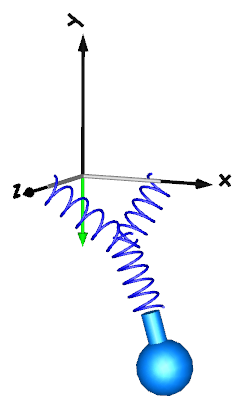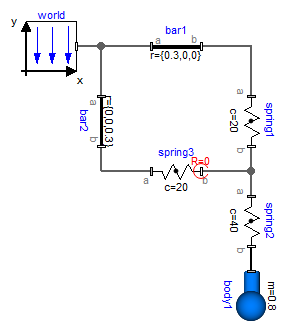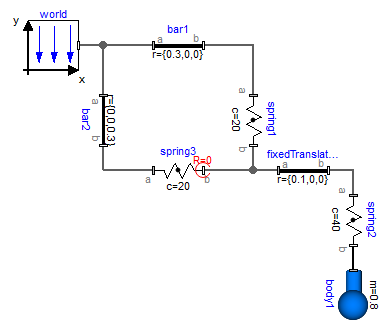ConnectionOfLineForces
Connection of LineForces
![]()
Library
Modelica/Mechanics/MultiBody/UsersGuide/Tutorial
Description
Line force elements, such as aSpring,are usually connected between two parts. In fact, this is the only possibilityin most multi-body programs. In an equation based system like Modelica, moregeneral connections are possible. In particular3-dimensional line force elements can be connected togetherin series without having a body with mass at theconnection point. This is advantageous since stiff systems can be avoided, say, due toa stiff spring and a small mass at the connection point.For an example, see modelThreeSprings:

Here, three springs are connected together at one point, without having a bodyat the connection point of the springs. There is one difficulty: In such a situationthe orientation object at the connection point is undefined, becausethe springs do not transmit torques. Translation will therefore fail, if three springsand a body are connected together in this way. To handle such a case, all line forceelements have flags "fixedRotationAtFrame_a" and "fixedRotationAtFrame_b" in their"Advanced" parameter menu. For example, if "fixedRotationAtFrame_b = true",the orientation object at frame_b is explicitly set to a null rotation, i.e.,
frame_b.R = Modelica.Mechanics.MultiBody.Frames.nullRotation();
This means that the coordinate system in the connection point of the three springsis always parallel to the world frame. When this option is selected, the correspondingframe in the line force icon is marked with a red circle and with the text "R=0".This is shown in the next figure, where this option is selected for spring3.frame_b:

Note, if this flag is not set to true, a translation error will occur.Due to the usage of overdetermined connectors in the MultiBody library, the errormessage will be something like: .
"The overdetermined connectors <...> are connected but do not have any root defined"
The two flags "fixedRotationAtFrame_a" and "fixedRotationAtFrame_b must be set very carefullybecause a wrong definition can lead to a model that simulates, but the simulationresult is wrong. This is the case whenever the movement of the resulting system dependson the orientation object that was arbitrarily set in parallel to the world frame.A typical example is shown in the next figure:

Here, spring3.frame_b.R is defined to be in parallel to the world frame.However, this is then also the orientation of fixedTranslation.frame_a, and thisin turn means that the left part of the fixedTranslation object is always in parallelto the world frame. Since this is not correct, this modelwill result in a wrong simulation resultThis system is mathematically not well-defined and does not have a solution.The only way to model such a system is by providing a mass and an inertia tensorto fixedTranslation. Then, the flags are not needed, because the "connection"point of the springs is a body where the absolution position vector and theorientation matrix of the body-fixed coordinate system are used as states.